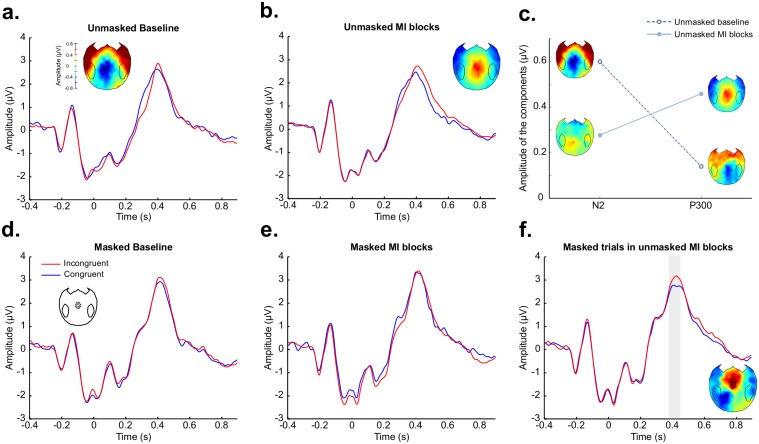Fig 3. Two ERP components: N2 and P300.
In panels (a), (b), (d), (e) and (f), ERP analyses from a cluster of 15 electrodes around Cz in different experimental conditions are presented, with incongruent trials in red and congruent trials in blue. The gray shadings indicate time periods of statistical significance (pcorrected < 0.05) and scalp topographies of the difference between incongruent and congruent trials show the effects of congruence during these time periods. (a) In the unmasked baseline, the N2 component is modulated by congruence from 272 ms to 364 ms after the target onset. (b) In unmasked mostly-incongruent (MI) blocks, the P300 component is modulated by congruence from 404 ms to 572 ms after the target onset. (c) The amplitude of the N2 and P300 components was computed as the absolute value of the difference between congruent and incongruent trials in the time windows of interest for each component. We found a significant interaction (F(1,19) = 6.67, p = 0.02) between the amplitude of the components and the experimental condition (unmasked baseline—dotted line/unmasked mostly-incongruent blocks—continuous line). Scalp topographies of the difference between incongruent and congruent trials for the time window of interest for each component and in each condition are plotted next to the corresponding point in the plot. (d) No significant difference was observed in the EEG between congruent and incongruent trials in the masked baseline condition. (e) No significant difference was observed in the EEG between congruent and incongruent trials in the masked baseline condition. (f) Interestingly, in the masked trials included in the unmasked mostly-incongruent blocks, a modulation of the P300 by congruence was observed from 384 ms to 452 ms after the target onset, similar to the signature observed for unmasked trials in mostly-incongruent blocks.

